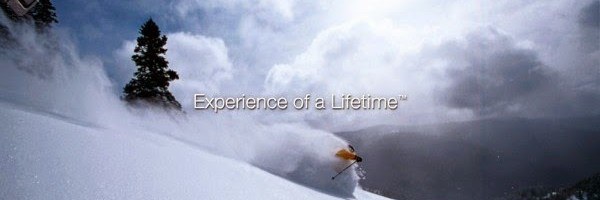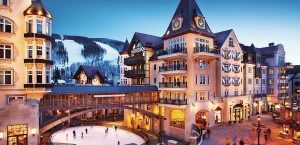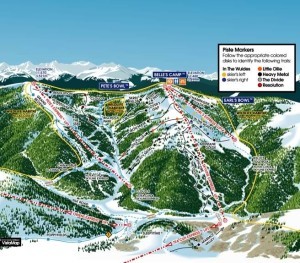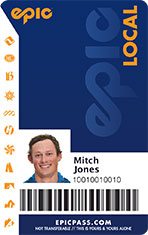Vail Resorts: Delivering a Premier Mountain Resort Experience

Vail Resorts’ operating model helps it to deliver the Experience of a LifetimeTM
Business model
Vail Resorts is a publicly traded mountain resort company that operates in three segments:
- Mountain (79% of FY15 sales): The Mountain segment owns and operates twelve mountain resorts and urban ski areas, including Vail, Beaver Creek, Breckenridge, Keystone, Park City, Canyons, and Heavenly. Revenues in this segment come from lift ticket sales, ski and snowboard school, dining, and retail and rental.[2]
- Lodging (18% of FY15 sales): The Lodging segment owns and manages a portfolio of luxury hotels through the RockResorts brand and hotels and condos near their ski resorts. In addition, the segment includes three destination resorts in Grand Teton National Park and several golf courses.[2]
- Real Estate (3% of FY15 sales): The Real Estate development segment owns, develops, buys, and sells real estate surrounding their resort communities.[2]
Vail Resorts describes themselves as “the premier mountain resort company in the world and a leader in luxury, destination-based travel at iconic locations.”[3] In order to be successful with this luxury mountain travel business model, they need to maintain their premier ranking, appeal to destination-based travelers, particularly those in the luxury market, and drive repeated trips. Putting it more simply, they must deliver the “Experience of a LifetimeTM” each and every time a guest visits.[3]
Operating model
Vertical integration to control the whole experience
Operating across its three segments allows Vail Resorts to control the entire customer experience from the time on the snow to shopping and dining venues to the accommodation options. Being in the skiing business, it seems natural that Vail Resorts would control the on-mountain services such as ski and snowboard school and dining. Owning and managing its lodging portfolio, however, allows the company to ensure high-end accommodations are available for its luxury travelers and that those accommodations have the proper up-keep and amenities expected by those travelers. Similarly, the real estate segment allows Vail Resorts to have a say in what the rest of the base areas of their mountains look like, from retail stores, to restaurants, to nightlife and other hotels. Altogether, this integration ensures a seamless luxury experience that appeals to affluent destination-based travelers.
Continual reinvestment in the experience
Vail Resorts’ continual investments to upgrade both infrastructure and services helps it to maintain its leading resort position and continue to provide the premier experience its luxury customers require. Last year, Vail Resorts spent $85mm on resort improvements and has spent $492mm since 2010.[5] These upgrades range from lift upgrades to streamline traffic and improved terrain parks to appeal to younger freestyle skiers to more extensive projects that truly change the experience of the resort. For example, in 2000 Vail opened Blue Sky Basin, an entirely new portion of the mountain that added 650 additional acres and 4 new high speed chairs.[6] Similarly, Vail Resorts plans to spend $50mm on upgrades to the newly purchased Park City resort in order to, among other things, add a gondola connecting it to nearby Canyons resort, upgrade on-hill dining, and add additional snow-making.[7]
Season pass program to lock in destination traveler this season and for many to come
Vail Resorts’ Epic Pass provides unlimited access to the company’s eleven U.S.-based resorts at a price that pays for itself in less than six days, but must be purchased during the proceeding spring.[9] This amazing value proposition gets destination travelers to commit to visiting in-network resorts before the season even starts (and snowfall can be gauged). The Epic Pass also automatically enrolls clients in the PEAKS Rewards program[9] – Vail Resorts’ loyalty program that enables people to earn points on their purchases and then redeem them for additional free lift tickets, ski and snowboard lessons, etc. The initial value proposition may pull in the destination traveler the first time, but then the Epic Pass combined with the PEAKS rewards helps to keep them going to affiliated resorts all season and again next year. This aligns with Vail Resorts’ business model as it attracts repeat visits from destination travelers, as well as their friends whom they convince to go with them, and then allows Vail Resorts to sell ski lessons, on-mountain dining, other activities, and accommodations in addition.
Addition of new services to drive luxury and loyalty
Vail Resorts continually adds new services and programs to appeal to higher-end customers and differentiate themselves from other resorts. Northstar California Resort offers a Primo Private Lesson, which includes a private ski instructor for the entire day, private ski fittings at your hotel, close-to-the-lift parking, and concierges to help book your off-the-slopes activities.[10] Several Vail resorts currently offer a First Tracks program where guests can pay ~$150 in addition to a lift ticket in order to eat breakfast and begin skiing before the mountain opens to the public.[10] This year, Beaver Creek will be debuting the White Carpet Club, which for $150 a day will allow you and up to three friends access to a private lounge with complimentary snacks and nonalcoholic drinks, personal locks, and concierge service.[7] These differentiated experiences appeal to luxury destination clientele and drive loyalty by offering experiences that cannot be easily replicated at other resorts.
Other activities to appeal to non-skiers and encourage longer trips
In order for its resorts to be more comprehensive destination vacation locations, Vail Resorts ensures resorts have many options for entertainment besides skiing and snowboard, including sightseeing, 4×4 jeep tours, tubing and other winter sports, horseback riding, shopping, spas, and golf courses.[1] These activities appeal to non-skiers within a group or family, making them more willing to choose a Vail resort for their destination. They also encourage longer stays at the resorts because there are activities and amusements besides skiing so people can take a day off from skiing and do something else. These other activities appeal to destination-based travelers, encourage them to stay longer, and fulfill luxury travelers’ expectations of a full-service experience.
Conclusion
Vail Resorts’ operating model and business model are aligned and work to support each other. The company’s operating decisions focus on maintaining its current premier resort status, a competitive advantage over other resorts, and attracting and retaining luxury destination-based travelers, which in turn drive performance for the company itself.
[1] Ski Paradise, “Vail Resorts Deliver Experience of a Lifetime Campaign with Exact Target Marketing Cloud,” Raul Revuelta website, http://nieveyalgomas.blogspot.com/2014/04/vail-resorts-deliver-experience-of.html, accessed December 8, 2015.
[2] Vail Resorts, Inc., FY15 Form 10K for the Period Ending July 31, 2015 (filed September 28, 2015), https://www.sec.gov/Archives/edgar/data/812011/000081201115000051/mtn2015073110-kforq4.htm, accessed December 7, 2015.
[3] Vail Resorts, Inc., “Who We Are,” Vail Resorts website, http://www.vailresorts.com/Corp/info/who-we-are.aspx, accessed December 7, 2015.
[4] RockResorts, “Your Luxury Ski Vacation Begins in Vail,” Arrabelle website, http://arrabelle.rockresorts.com/, accessed December 8, 2015.
[5] “Vail Resorts Offers Unlimited Skiing and Riding at Vail, Beaver Creek, Breckenridge, Park City and more on the 2015-16 Epic Pass, Now on Sale at $769,” Vail Resorts press release, March 10, 2015, http://investors.vailresorts.com/releasedetail.cfm?ReleaseID=900890, accessed December 7, 2015.
[6] Vail Resorts, Inc., “Heritage,” Vail Resorts website, http://www.vailresorts.com/Corp/heritage.aspx, accessed December 7, 2015.
[7] “Vail Resorts to Invest an Unprecedented $50 Million in Park City Mountain Resort in One Season and Create the Largest Ski Resort in the U.S.,” Vail Resorts press release, December 8, 2014, http://investors.vailresorts.com/releasedetail.cfm?ReleaseID=886500, accessed December 7, 2015.
[8] Powder Travel, “Vail ski resort area trail map Blue Sky Basin,” Powder Travel website, http://www.powdertravel.com/resort_trail_map/Vail%20Ski%20Resort%20Map%20blue%20sky%20basin.htm#.Vmdxvb_CvKs, accessed December 8, 2015.
[9] Vail Resorts, Inc., “Pass Benefits,” Vail Resorts website, http://www.snow.com/epic-pass/pass-benefits.aspx, accessed December 7, 2015. (Picture from “Epic Pass Local”)
[10] Andrea Petersen, “New Ways to Ski First Class,” The Wall Street Journal, November 3, 2015, http://www.wsj.com/articles/new-ways-to-ski-first-class-1446578066, accessed December 7, 2015.
[11] Beaver Creek, “White Glove First Tracks,” Beaver Creek website, http://www.beavercreek.com/planyourtrip/white-glove-first-tracks.aspx, accessed December 8, 2015.







It was very interesting to learn how they approach/think about the integrated customer experience from arrival to departure! I’d be curious t o know about how much customer data do they manage to collect and if they leverage on it in order to generate loyalty and potentially mitigate seasonality?
Makes me want to ski! Now that Vail Resorts has scaled to own 12 different mountains, I wonder what impact that expansion has on their operating or business models — and is it consistent with what their customers currently expect. I’d imagine some growing pains from when they just owned one or two mountains in Colorado. Should the expansion continue, and will it hurt or help their value proposition?
I can imagine a couple issues that they might need to think about while expanding, but I’m sure there are a lot more: (1) the Epic pass allows consumers to visit multiple mountains rather than remain loyal to one; (2) it could be harder to claim that your destination is the “Experience of a LifetimeTM” if you need to do that for each of a large number of different destinations.
I found the season pass option to be incredibly interesting. I had no idea that Vail owned such a large number of slopes and creating a hotel group like reward program seems like a great way to increase traffic across its properties. However, do you think there could be a customer backlash due to the increasing number of acquisitions?